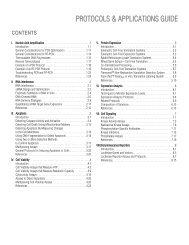2012 Promega catalogue
2012 Promega catalogue
2012 Promega catalogue
Create successful ePaper yourself
Turn your PDF publications into a flip-book with our unique Google optimized e-Paper software.
Life<br />
Science<br />
Catalog<br />
<strong>2012</strong><br />
Worldwide Contact List<br />
Section<br />
Contents<br />
Table of<br />
Contents<br />
Cell Signaling<br />
24<br />
MAO-Glo Assay Systems<br />
Product Size Cat.# Price ($)<br />
MAO-Glo Assay 200 assays V1401 223.00<br />
1,000 assays V1402 803.00<br />
MAO-Glo Assay with MAO-A 1,000 assays V1560 1173.00<br />
Available Separately<br />
MAO-A<br />
For Research Use Only. Not for Use in Diagnostic Procedures.<br />
500 µl V1452 417.00<br />
Description: The MAO-Glo Assay provides a homogeneous luminescent<br />
method for measuring monoamine oxidase (MAO) activity from recombinant<br />
and native sources and for testing the effects of test compounds on MAO<br />
activity. The MAO-Glo Assay is performed by incubating the MAO enzyme<br />
source with a luminogenic MAO substrate. The substrate of the MAO-Glo<br />
Assay is a derivative of beetle luciferin. Upon reaction with MAO, the derivative<br />
is converted into luciferin, which in turn reacts with luciferase to produce light.<br />
The amount of light produced is directly proportional to the activity of MAO.<br />
After the MAO reaction has been performed, the reconstituted Luciferin Detection<br />
Reagent is added. The reagent simultaneously stops the MAO reaction and<br />
initiates a stable glow-type luminescent signal with a half-life greater than 5<br />
hours. This eliminates the need for strictly timed luminescent detection.<br />
The MAO-Glo Assay with MAO-A contains human recombinant MAO-A<br />
enzyme expressed in yeast. The kit is very well suited for the rapid assessment<br />
of potential inhibition of MAO-A by new chemical entities and can be used for<br />
higher throughput applications such as primary screening. The MAO-A enzyme<br />
is also available separately.<br />
The MAO-Glo Assay includes a luminogenic MAO substrate, two MAO Reaction<br />
Buffers (one that can be used with either MAO A or MAO B enzyme and<br />
one that is designed specifically for MAO B), a lyophilized Luciferin Detection<br />
Reagent and the Luciferin Detection Buffer. The user supplies the sample material<br />
containing MAO. Protocols are configured for multiwell plate formats but<br />
easily can be adapted for single-tube applications.<br />
Features:<br />
• Complete Solution: The MAO-Glo Assay with MAO-A contains monoamine<br />
oxidase A enzyme for convenient assessment of the effects of new<br />
chemical entities on MAO-A activity.<br />
• Speed: The luminescence format eliminates the need for time-consuming<br />
analyses such as HPLC.<br />
• Simplified Method: The simple “add and read” protocol makes the assay<br />
amenable to high-throughput screening in multiwell plates.<br />
• Greater Sensitivity: Less MAO enzyme is required in these assays than in<br />
typical HPLC or fluorometric methods because of the enhanced sensitivity.<br />
• No Fluorescence Interference: Luminescent output eliminates interference<br />
from fluorescent test compounds.<br />
• Stable Signal: “Glow-type” luminescence provides a stable signal with a<br />
half-life of greater than 5 hours. This eliminates the need for strictly timed<br />
luminescent detection.<br />
Storage Conditions: Store MAO-A enzyme (Cat.# V1452) at –70°C. Store all<br />
other components at –20°C protected from light.<br />
Protocol Part#<br />
MAO-Glo Assay Technical Bulletin TB345<br />
UGT Activity Assays<br />
Product Size Cat.# Price ($)<br />
UGT-Glo Assay 200 assays V2081 480.00<br />
1,000 assays V2082 Pls. Enq.<br />
UGT-Glo UGT1A1 Screening System 200 assays V2120 865.00<br />
1,000 assays V2121 Pls. Enq.<br />
UGT-Glo UGT2B7 Screening System 200 assays V2130 865.00<br />
1,000 assays V2131 Pls. Enq.<br />
For Research Use Only. Not for Use in Diagnostic Procedures.<br />
Description: The UGT-Glo Assay is a luminescent method for measuring<br />
UDP glucuronosyltransferase (UGT) activity. The UGT-Glo Assay measures<br />
UGT activity from a variety of sources, such as microsomes containing<br />
recombinantly expressed enzymes or microsomal preparations derived from<br />
mammalian tissues, and to test the effects of various chemicals on UGT activity.<br />
The assay involves incubating UGT with a proluciferin substrate; a portion of<br />
the substrate gets conjugated with UDP, while the remainder is unmodified.<br />
Upon the addition of d-Cysteine, the unconjugated proluciferin is converted<br />
into luciferin and, in a coupled reaction with luciferase/luciferin, is converted<br />
into light. Conjugated proluciferin remains intact and does not contribute to<br />
the luminescence. Thus, the signal generated is inversely correlated with UGT<br />
activity present in the sample.<br />
The UGT-Glo Assay contains two proluciferin substrates: the UGT Multienzyme<br />
Substrate, which is compatible with a wide range of UGTs, and the<br />
UGT1A4 Substrate, which reacts specifically with UGT1A4. The kit also contains<br />
Luciferin Detection Reagent and Reconstitution Buffer, UGT Buffer, d-Cysteine<br />
and UDPGA. The UGT-Glo Screening Systems contain the above reagents as<br />
well as the respective UGT isoforms and control membranes.<br />
Features:<br />
• Speed: The luminescent format eliminates the need for time-consuming<br />
analyses such as HPLC and LC/MS.<br />
• Simplified Method: The simple “add and read” protocol makes the assay<br />
amenable to higher throughput screening in multiwell plates.<br />
• Sensitive: Allows researchers to use less enzyme and scale down reaction<br />
volumes, which saves on reagent costs.<br />
Storage Conditions: Store UGT enzymes and Control Membranes at –70°C.<br />
Store remaining components at –20°C.<br />
Protocol Part#<br />
UGT-Glo Assay Technical Bulletin TB551<br />
For complete and up-to-date product information visit: www.promega.com/catalog
















